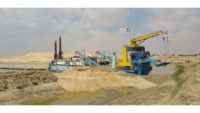
In an attempt to rekindle national pride and demonstrate his administration’s ability to move the country beyond a turbulent political period, Egyptian President Abdel Fattah al-Sisi last August announced that the Suez Canal would be expanded to enable more vessels to transit the waterway and boost the country’s revenues.
Now in the early stages of construction, the expansion project is estimated to cost $4 billion, and while Egypt’s new president called for the project to be complete within a year, that optimistic target likely will give way to the challenge of building a new channel and new facilities.
Expanding the commercial waterway is only part of the Suez Canal Development Project, which aims to build six new ports and related facilities, infrastructure and industrial zones along the canal. Further, a technology park is to be constructed in the Ismailia area.
A strategic development plan goes beyond the expansion of the canal to include the development of the entire Suez Canal region, a plan that will require an investment amounting to $8.4 billion—all of which will be financed by the Egyptian people.
Current plans call for development schemes that will cover some 76,000 sq kilometers along or near the waterway’s 161-km-long course.
The Suez Canal Authority (SCA) in August contracted the Cairo office of international consultant group Dar Al-Handasah to create an overall strategic master plan for the project, which is scheduled to be complete in March 2015.
Part of Dar Al-Handasah’s mandate is to identify investment opportunities among the numerous industrial, logistical and infrastructure projects that will attract foreign investment to Egypt. Located primarily at the new ports planned within the canal area, these projects will each have their own master plan.
Recently, the American Chamber of Commerce in Cairo hosted a meeting there between Dar Al-Handasah and 35 American companies to discuss investment opportunities. As the project progresses, more international operators are expected to show interest.
Meanwhile, SCA is supervising the digging that is now underway in the Sinai Peninsula. Egyptian army engineers are orchestrating work that involves more than 50 local companies. They are excavating and hauling tons of earth and rock in order to carve out a new 72-km channel that will run parallel for half the length of the existing canal, which was completed in 1869 after 10 years of work.
The canal currently can accommodate the passage of 49 vessels per day, but the new channel will expand that capacity to 97 vessels per day. Furthermore, the new waterway will be expanded to enable ships to pass one another, a move they cannot do now. The new channel also will reduce a vessel’s overall waiting time to transit the canal to three hours from 11 hours.
Estimated to handle 7.5% of the world’s container-ship traffic—more than the Panama Canal, according to the World Shipping Council—the Suez in 2013 took in 16,596 vessels, with an average annual revenue of $5 billion. The expansion plan sees revenues from transit fees rising to $13 billion by 2023.
Contract Details
Since August, a number of contracts have been signed for infrastructural development and dredging work.


Post a comment to this article
Report Abusive Comment